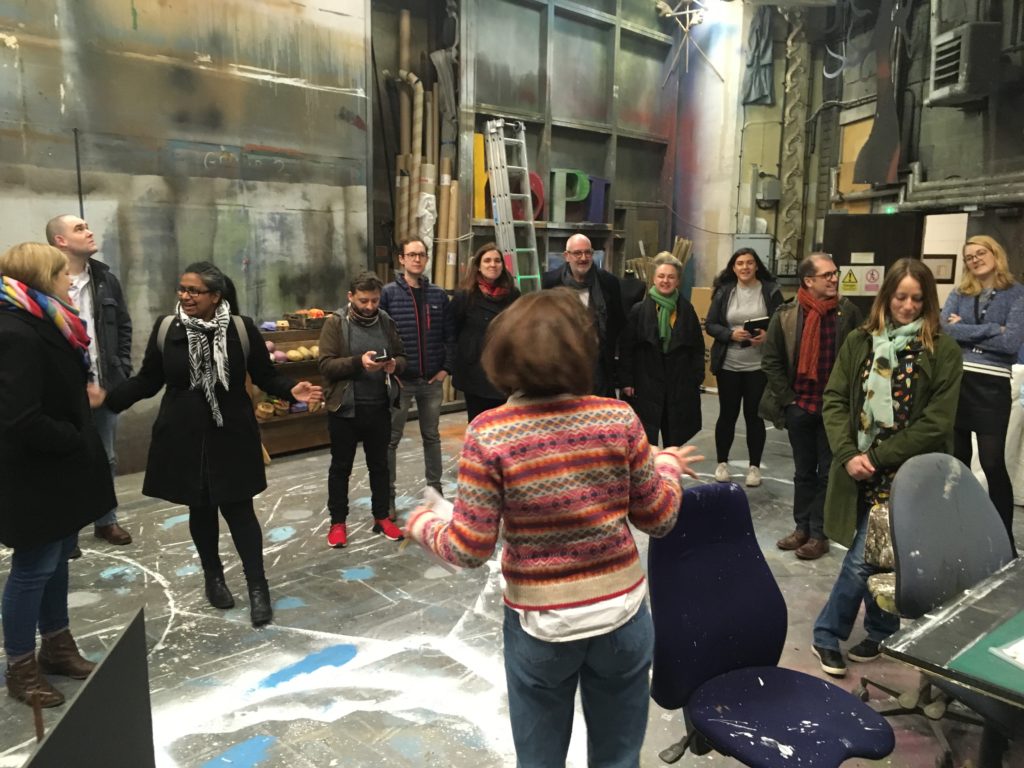
15.01.19

Fabric started back in November as a peer-learning project bringing a wide variety of participants together to explore different aspects of creative leadership in the city. It is a chance for those involved to learn from each other but also from visits to key organisations and groups in Dundee.
The December session was the first Fabric meet-up and it included visits to both Dundee Contemporary Arts and Dundee Rep Theatre, specifically to hear about their learning teams and spaces. Starting up at the DCA, we heard about the Learning Room, a space that had rarely featured in this type of cultural environment. Its offer goes much beyond a ‘kids’ room’, it creates opportunities for learning to happen and reflecting on the themes presented at DCA’s broader programme.
Not only in connection to that room, but the entire learning team at DCA also operates with the goal of ‘enriching people’s lives through art and culture‘, as DCA director, Beth Bate, strongly believes. This was confirmed by a Fabric participant who explained he used the Print Studio even back when he lived in Edinburgh as it was better and more accessible than the local ones. Once again in the director’s words, all of this is offered because ‘we are a civic building and we have a civic responsibility‘. The Print Studio is curated to be open and accessible to a broad range of audiences, from hobbyists to professionals, and even became the hub of independent initiatives like the Dundee Print Collective, which engages with both artists and individuals with no formal art training in collective projects.
Amazing morning @dca with @Creative_Dundee #fabric @beth_bate on co-designing learning programmers both inside and beyond civic space pic.twitter.com/0b6eTVMBE3
— Hazel White (@HazeloneWhite) December 13, 2018
While at the DCA we explored the defining characteristics of a learning space and its motivations, at Dundee Rep Theatre the conversation turned to the practicalities of engaging with communities in Dundee. How do they let people know about the opportunities inside? Is it about bringing people in or going to their communities?
Quite a bit of our time there was spent touring the incredible spaces and resources at the Rep, in awe of the backstage world that goes into creating what the audience usually sees on any given performance. Dundee Rep has used these resources for all sorts of different projects – from across age and abilities drama groups to apprenticeships and immersive work experience like Enterprise, which invites 80 young people from across the city to gain real-life experience of working within a theatre. In a sense, that is how they have answered the question of engagement, by using their building as a hub that responds to the needs of the communities around them. On most days of the week, you can hear activity all through the building from groups of all ages engaging in a wide variety of activities.
This was a reflection that can sum up the entire morning. Creative leadership in Dundee is, in part, about looking at one’s resources and intelligently opening them up to the needs of different communities.
Finally, the day turned into something a little different. At the Vision Building we met with artist, curator and peer-educator Jonathan Baxter, currently working on projects like On-Site Projects and Dundee Urban Orchard. In an energetic session, we explored the path between values, theories and practical attempts to having an impact within our communities.
In a reflection exercise, we had to continually reposition ourselves in physical scales (drawn on the floor) of where we were at with our own practice and community involvement. Was our current work about acting? Observing? Reporting? Researching? How subversive was our work 5 fives ago? How communal? What about now?
Physically reflecting on different aspects of our work and hearing everyone else’s rationale about how they made their choices was uniquely insightful. By realising others have similar patterns or feel similarly about certain approaches was beneficial, it allowed participants to both see themselves as part of a larger, like-minded community while also learning from the differences – and complementarities! – within the group.
On this afternoon session, there was too much going on, and too many insights generated for it all to be accounted here – perhaps this kind of activity can now be passed from Fabric members into their own groups and communities.
Overall, the day was about creative learning but also the bridges we build to deliver/receive it – which are the bridges of mutual engagement. As if it were a visual aid in itself, to a much larger lesson, that’s exactly what the participants did through the day by asking questions, sharing insights and offering moments of vulnerability.
We’ll be back next month to share more about this communal learning. Read more about the Fabric programme and participants here.
Such a brilliant range of folk joined us today, exploring various forms of creative city leadership, learning and activism, with a smidge of Christmas cheer at the first #FabricDundee – thanks everyone + hosts for your thoughtful contributions. More info: https://t.co/f6ozF17J8q pic.twitter.com/IKGLK7LIom
— Gillian Easson (@GillianEasson) December 13, 2018

If you would like to support us in creating even better content, please consider joining or supporting our Amps Community.